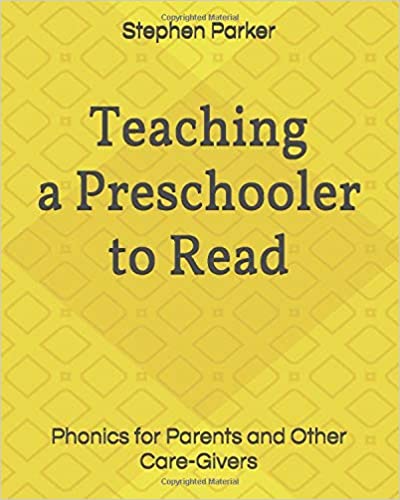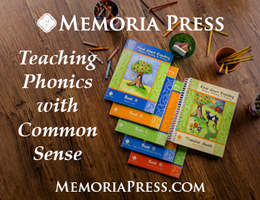In Teaching a Preschooler to Read, now in its second edition, Stephen Parker presents a synthetic phonics program that can actually be used to teach all ages. Synthetic phonics is a systematic approach that works from the bottom up, teaching phonograms before putting them together as words. (Note: Synthetic phonics is often called systematic phonics.)
The program is contained within a 257-page book, and all you need to use with it are index cards on which you will write letters and words. If you are teaching a preschooler, you should also use some sort of movable alphabet letters that children can handle themselves.
Parker has made the PDF version available for free through his website, but a print version is also available.
Teaching a Preschooler to Read requires quite a bit of preparatory work from parents. However, parents with little phonics background will learn phonics themselves as they learn how to teach their child.
In the first three chapters, Parker presents his rationale for teaching preschoolers to read, explains the nature of reading and spelling, and expands upon synthetic phonics as the best approach. The reading program starts on page 43 and is presented in 18 stages, beginning with stage 0.
Stage 0 begins with letter recognition as is appropriate with preschoolers. You can skip that stage if your student is beyond it. The goal at this stage is for children to be able to recognize both lower- and upper-case letters and be able to put them in alphabetical order. Numbers from zero to nine should be learned as well. Parker addresses the use of digital apps at this stage, recommending those that teach only the letters but not their sounds. He checked out many of them, discarding most. He leaves his readers with four specific recommendations, a big help for parents interested in apps.
Parker then lays out a sequence for teaching phonics from stage 1 and beyond. The program teaches 44 elemental sounds, but it also teaches the various ways each of those sounds might be constructed with different phonograms.
The first stage introduces short vowels with the consonants m, n, and s. These sounds can readily be formed into words, so students learn to read actual words. Of course, this involves learning to blend sounds together into words and might take quite a while. Other consonants and consonant digraphs are taught before long vowels are introduced in stage 10.
Children start to read complete sentences in stage 8. As children learn to read sentences, you will be writing out sentences on a whiteboard or paper for a child to practice reading. Stage 8 concludes with six pages of sentences in a large font for children to read directly from the book. Stage 11 has even more pages of practice sentences for children to read. Stage 14 starts to combine sentences into paragraphs for practice and also adds some nursery rhymes. According to Parker, by the end of Stage 17, children should be reading independently at third-grade level.
Appendices are referenced in most of the stages. The appendices are where you will find lists of practice words pertinent to the lessons you are teaching. You will need to create flashcards for children to practice these words. If you are teaching older students, you might find that students learn the words so quickly that they can read them directly from the appendices and you don’t need to create flashcards. Also in the appendices are two other very useful sections I want to point out. Appendix Q has a chart of all the phonograms and their possible sounds—the basic "code" of phonics presented from a reading perspective. In Appendix P, you can find all the same information, but from a spelling perspective. In many ways, Teaching a Preschooler to Read prepares children for both reading and spelling.
As Parker explains, the time for each stage in the sequence is not set. Some children will pass quickly from one stage to another while others need more time at certain stages. Because of that, there are no daily lesson plans or specifics about what to do every day. He also recommends using learning opportunities that are in the environment such as having preschoolers practice identifying letters and numbers on license plates, an approach that fits very well with homeschooling.
Parker uses some unusual approaches. For example, he uses slanted lines to enclose letters that indicate the actual pronunciation as is commonly done when teaching phonics. However, rather than using diacritical marking with vowels, he simply uses upper case vowels to indicate long vowels and lower-case vowels to indicate short vowels. He spells out sounds with multiple letters rather than using unusual diacritical markings. While this isn’t standard, it works and keeps things simple.
One of the few things I question is the amount of time Parker recommends parents spend on each phonics session. He recommends 30 to 45 minutes per day for explicit teaching and practice plus 20 to 30 minutes a day reading aloud with children’s literature. If you try to keep a preschooler occupied with flashcard-based instruction for 30 minutes or more, it won’t work. However, if a good part of that time is spent with the child manipulating letters (plastic, foam, etc.) in a playful fashion while learning, you can maintain their attention much longer. Breaking up learning sessions is also a good idea with preschoolers.
Parents need to read through the lesson material before teaching their child. Also, you want those flashcards prepared ahead of time or your child will lose interest while you stop to create them. Parents can work just ahead of their child and need not read the entire book before they begin. Still, scanning ahead might be beneficial.
Teaching a Preschooler to Read is surprisingly comprehensive, and I haven’t even mentioned the minor attention given to grammar and math.











